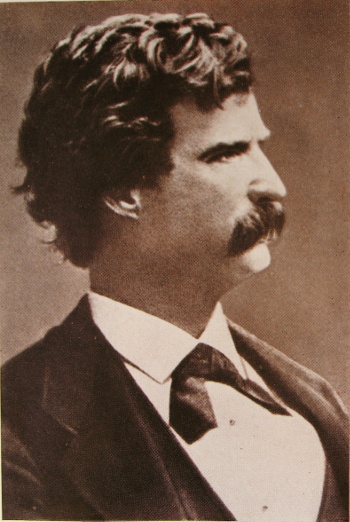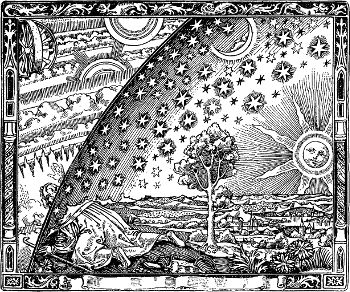Is Science Simply Beautiful?
August 26, 2019
My
elementary school education was fueled by the
public domain.
School boards don't want to spend
money on expensive
textbooks, so textbook
publishers will use as much free content as possible to keep prices low.
Music class contained such classics as the
U.S. Field Artillery March and
Stephen Foster's Camptown Races, while our
English Literature curriculum included
George Eliot's Silas Marner,
Nathaniel Hawthorne's The Scarlet Letter, and
Mark Twain's The Adventures of Tom Sawyer.

Samuel Langhorne Clemens (1835-1910), a.k.a., Mark Twain, as a young man in a photograph possibly taken around 1865.
Twain had a great interest in science and technology. He was friends with Nikola Tesla, and he was granted U.S. Patent No. 140,245 (June 24, 1873), for a scrapbook in which adhesive on the pages was moistened to affix items.[1]
Twain lost $300,000 (about $9 million in today's money) in his funding of the development of the Paige Compositor. This typesetting machine had many problems, and it was surpassed by the Linotype.
(Wikimedia Commons image.)
Likewise, the 1794
poem,
The Tyger, by
English poet,
William Blake (1757-1827), would always be a part of every poetry section; so much so that saying the first line, "Tyger Tyger, burning bright," to a group of
my generation will still evoke as a
chorus the second line, "In the forests of the night." The poem continues, "What immortal hand or eye, Could frame thy fearful symmetry?" Blake saw
symmetry in the tiger, since symmetry is ubiquitous in
nature.
Since
atoms will align themselves into
regular arrays in
crystals, we see symmetry in natural
gemstones. With the advent of the
microscope, the symmetry of
snowflakes, caused by the regular arrangement of hydrogen-bonded water molecules as ice grows from a central seed, became apparent. The symmetrical body plan of animals is also apparent, and this is seen also in microscopic organisms.

Left images, snowflakes photographed at Jericho, Vermont, by Wilson Alwyn Bentley in 1902. Right image, portion of Plate 58 (Tripocyrtida, Sethocyrtida, Phormocyrtida et Theocyrtida), an engraving by Adolf Giltsch (1852-1911), from the Report on the Radiolaria collected by H.M.S. Challenger during the years 1873-1876, Part III, by Ernst Haeckel (1834-1919). (Images via Wikimedia Commons.)
Not only does nature exhibit many examples of symmetry, it seems that
humans are designed to admire symmetry. In particular, we find
facial symmetry to be
attractive, possibly as a marker of
genetic quality, the possessor having
good genes. A 1999 study by
psychologists at the
University of St. Andrews (Scotland, UK) demonstrated that the more symmetric a
face, the more attractive the person, with the possibility that facial symmetry might be a factor in
mate selection.[2]
Our preference for symmetry extends to our
art and
artifacts. While the symmetry of
pottery can be explained by its traditional method of
manufacture on a
potter's wheel,
buildings are symmetric for no reason other than
aesthetics.
Textile items, such as
quilts,
carpets and rugs, usually contain a symmetric
pattern. Humans appear to have a definite affinity for symmetry.

Symmetry in lacework.
My maternal grandmother would crochet similar items hour after hour in her rocking chair.
(Wikimedia Commons image by Rodrigo Argenton)
Symmetry was so important to early
cosmologists that they supposed that the
universe was built from nested
celestial spheres. When that notion became suspect,
Kepler decided in his 1596 book,
Mysterium Cosmographicum (1596), that the
Solar System was modeled on nested
regular polyhedra. Eventually, the search for
physical laws became a search for symmetry, and this is no more apparent than the evolving
models of the
elementary particles that led to the
Standard Model.
Galileo, the father of modern
physics, applied
mathematics to his
experimental data, and he was one of the first to believe that nature obeys mathematical laws. As he wrote in
The Assayer:
"[The universe] is written in the language of mathematics, and its characters are triangles, circles, and other geometric figures, without which it is humanly impossible to understand a single word of it..."[3]
Why the universe can be explained this way is a
mystery.
Eugene Wigner expressed this
idea in a 1960
paper entitled,
The Unreasonable Effectiveness of Mathematics in the Natural Sciences.[4] As he writes in this paper,
"It is difficult to avoid the impression that a miracle confronts us here... The observation which comes closest to an explanation for the mathematical concepts' cropping up in physics which I know is Einstein’s statement that the only physical theories which we are willing to accept are the beautiful ones. It stands to argue that the concepts of mathematics, which invite the exercise of so much wit, have the quality of beauty."
Perhaps
Isaac Newton thought that his 1687
equation for
gravitation, discovered more than a
centuryy and a half after Galileo's 1604
falling body equation, was beautiful. Newton's beautiful equation needed a application of
makeup in the
20th century when its deficiencies led to Einstein's 1915
general theory of relativity. Similarly, the early models of the Solar System and the Universe, while simple and thereby beautiful, needed extensive reworking into uglier depictions with circles being replaced by
ellipses and a
steady state cosmology being replaced by
universal expansion.

A wood engraving from page 163 of Camille Flammarion's, L'Atmosphère: Météorologie Populaire (Paris, 1888).
In this image, a pilgrim breaks through a barrier to view the inner workings of the universe that includes a wheel-in-a-wheel mechanism.
Flammarion was an astronomer and a science fiction author who believed that intelligent life existed on Mars.
(Wikimedia Commons image. Click for larger image.)
In a recent article on
Aeon,
Massimo Pigliucci, a
professor of
philosophy at the
City University of New York, writes that the idea that truth is recognizable by its beauty and simplicity is indefensible.[5] Indeed, the idea that "
beauty is in the eye of the beholder," a variant of the
Latin adage, "
de gustibus non disputandum est," ("there's no accounting for taste") should have been sufficient warning of the problem with this approach. In the Aeon article, Pigliucci further states that this idea of beauty has generated today's unfortunate focus on mathematics in physics theory. Similar sentiments have been registered on Aeon by
Sabine Hossenfelder, a
research fellow at the
Frankfurt Institute for Advanced Studies, who has written a book on this topic.[6-7]
Pigliucci cites
Lee Smolin's book,
The Trouble with Physics,[8] a
diatribe against
String Theory, for evidence against today's idea that we should
follow the math to the exclusion of all else. I wrote about Smolin's book in an
earlier article (Falsifiability, September 15, 2016). Such sentiments are also contained in
Peter Woit's book,
Not Even Wrong.[9-10] The title of Woit's book derives from
Wolfgang Pauli's famous
assessment of a proposed physics theory. Pigliucci wrote about String Theory in an earlier article in Aeon in which he states that physicists don't seem to hold philosophy in high regard.[11]
Pigliucci writes that the connection between beauty and truth was first proposed by
Plato in his
Symposium.[12] The idea that physical theories should be both simple and beautiful was held by the
Nobel Physics Laureate,
Paul Dirac; and his fellow Laureate,
Richard Feynman, said that "You can recognize truth by its beauty and simplicity."[5] As Pigliucci explains, the simplicity of which Dirac and Feynman spoke is not the simplicity manifest in
Ockham's razor. Ockham’s razor is an
epistemological principle about how things are known, while Dirac and Feynman's simplicity is a
metaphysical principle about the fundamental nature of reality.[5] I wrote about how metaphysical ideas have influenced science in an
earlier article (Metaphysics, November 12, 2018).
Pigliucci concludes that "there is absolutely no reason to think that we evolved an
aesthetic sense that somehow happens to be tailored for the discovery of the ultimate theory of everything."[5] He suggests that physicists should engage with philosophers in an
interdisciplinary dialogue.
References:
- Samuel L. Clemens, "Improvement in scrap-books," US Patent No. 140,245 (June 24, 1873).
- David I. Perrett, D. Michael Burt, Ian S. Penton-Voak, Kieran J. Lee, Duncan A. Rowland, and Rachel Edwards, "Symmetry and Human Facial Attractiveness," Evolution and Human Behavior, vol. 20, no. 5 (September, 1999), pp. 295-307, https://doi.org/10.1016/S1090-5138(99)00014-8.
- Galileo quotations on Wikiquotes; Selections of a translation of The Assayer; Stillman Drake, "Discoveries and Opinions of Galileo," Doubleday & Co.(New York, 1957), pp. 231-280.
- E.P. Wigner, "The unreasonable effectiveness of mathematics in the natural sciences," Communications on Pure and Applied Mathematics, vol. 13, no. 1 (February, 1960). pp. 1-14. A PDF file is available, here.
- Massimo Pigliucci, "Richard Feynman was wrong about beauty and truth in science," Aeon, June 28, 2019.
- Sabine Hossenfelder, "Beauty is truth, truth is beauty, and other lies of physics," Aeon, July 11, 2018.
- Sabine Hossenfelder, "Lost in Math: How Beauty Leads Physics Astray," Basic Books (June 12, 2018), 304 pp., ISBN-13: 978-0465094257 (via Amazon).
- Lee Smolin, "The Trouble With Physics: The Rise of String Theory, The Fall of a Science, and What Comes Next," Mariner Books (Reprint edition, September 4, 2007), 416 pp., ISBN-13: 978-0618918683. Also at Amazon.
- Peter Woit, "Not Even Wrong: The Failure of String Theory & the Continuing Challenge to Unify the Laws of Physics,"Basic Books (Reprint edition, September 4, 2007), 320 pp, ISBN-13: 978-0465092765 (via Amazon).
- Not Even Wrong, This Blog, July 29, 2008.
- Massimo Pigliucci, "Must science be testable?" Aeon, August 10, 2016.
- Plato, Symposium (360 BC), Benjamin Jowett, Trans., MIT Classics Website.
Linked Keywords: Elementary school; education; public domain; board of education; school board; money; textbook; publishing; publisher; music; classroom; class; U.S. Field Artillery March; Stephen Foster; Camptown Races; English Literature; curriculum; George Eliot; Silas Marner; Nathaniel Hawthorne; The Scarlet Letter; Mark Twain; The Adventures of Tom Sawyer; Samuel Langhorne Clemens (1835-1910); photograph; science; technology; Nikola Tesla; United States patent; scrapbook; adhesive; page; moisture; moisten; inflation; today's money; research and development; Paige Compositor; typesetting machine; Linotype machine; Wikimedia Commons; poetry; poem; The Tyger; English; William Blake (1757-1827); baby boomer; my generation; refrain; chorus; symmetry; nature; atom; crystal structure; regular array; crystal; gemstone; microscope; snowflake; Jericho, Vermont; Wilson Alwyn Bentley; Clathrocyclas; Tripocyrtida, Sethocyrtida, Phormocyrtida, Theocyrtida; engraving; Adolf Giltsch (1852-1911); Radiolaria; Challenger expedition; H.M.S. Challenger; Ernst Haeckel (1834-1919); human; facial symmetry; physical attractiveness; attractive; gene; genetic; psychologist; University of St. Andrews (Scotland, UK); face; mate choice; mate selection; art; cultural artifact; pottery; manufacturing; manufacture; potter's wheel; building; aesthetics; textile; quilt; carpet; rug; pattern; lacework; grandparent; maternal grandmother; crochet; rocking chair; Rodrigo Argenton; cosmology; cosmologist; universe; celestial sphere; Johannes Kepler; Mysterium Cosmographicum (1596); Solar System; regular polyhedron; physical law; conceptual model; elementary particle; Standard Model; Galileo Galilei; physics; mathematics; experiment; experimental; data; The Assayer; triangle; circle; geometry; geometric figure; unsolved problems in physics; mystery; Eugene Wigner; idea; scientific literature; paper; The Unreasonable Effectiveness of Mathematics in the Natural Sciences; miracle; physics; physical; theory; beauty; beautiful; wit; Isaac Newton; equation; gravitation; century; falling body equation; cosmetics; makeup; 20th century; General relativity; ellipse; steady state cosmology; metric expansion of space; universal expansion; Camille Flammarion, L'Atmosphère: Météorologie Populaire (Paris, 1888), pp. 163; Flammarion engraving; wood engraving; pilgrim; barrier; Ophanim; wheel-in-a-wheel; astronomer; science fiction; author; intelligence; intelligent; extraterrestrial life; Mars; Aeon (digital magazine); Massimo Pigliucci; professor; philosophy; City University of New York; beauty is in the eye of the beholder; Latin; adage; >de gustibus non disputandum est; Sabine Hossenfelder; research; fellow; Frankfurt Institute for Advanced Studies; Lee Smolin; The Trouble with Physics; diatribe; String Theory; Peter Woit; Wolfgang Pauli; Not even wrong; assessment; Plato; Symposium (Plato); Nobel Prize in Physics; Nobel Physics Laureate; Paul Dirac; Richard Feynman; >Ockham's razor; epistemology; epistemological; metaphysics; metaphysical; interdisciplinary; dialogue; Samuel L. Clemens, "Improvement in scrap-books," US Patent No. 140,245 (June 24, 1873).